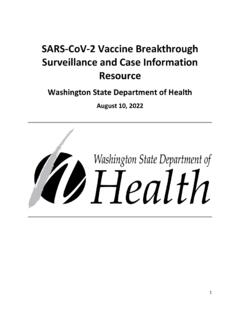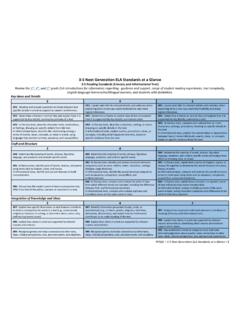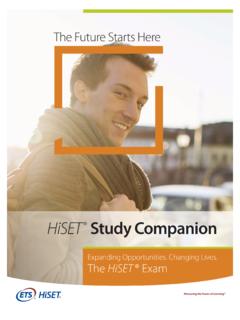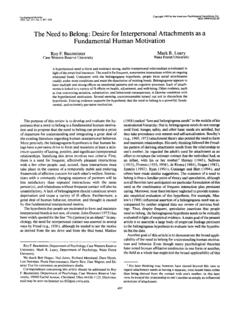Transcription of Suicidal Ideation, Suicide Attempt, or Self-Inflicted Harm
1 Suicidal Ideation, Suicide Attempt, or Self-Inflicted Harm: Pediatric Emergency Department Visits,2010 2014 and 2016 Updated: November 5, 2019 Recommended Citation: Suicidal Ideation, Suicide Attempt, or Self-Inflicted Harm: Pediatric Emergency Department Visits, 2010 2014 and 2016. Healthcare Cost and Utilization Project. ONLINE. November 5, 2019. Agency for Healthcare Research and Quality. Suicidal Ideation, Suicide Attempt, or Self-Inflicted Harm: Pediatric Emergency Department Visits, 2010 2014 and 2016 Suicide is a major preventable health concern for in the United States, especially in the pediatric population.
2 While Suicide is preventable, it does require intervention. Emergency departments (EDs) have been identified as an important site of care to identify individuals at risk, to provide timely support and intervention, and to facilitate entry into more intensive treatment, if Information on trends in ED utilization related to Suicidal ideation, Suicide attempt, or Self-Inflicted harm help inform resource needs. The following tables show trends in ED visits for patients aged 5 14 years old related to Suicidal ideation, Suicide attempt, or Self-Inflicted harm using the Healthcare Cost and Utilization Project (HCUP) Nationwide Emergency Department Sample (NEDS).
3 ED visits include those for patients who were treated in the ED and subsequently discharged home, admitted to the same hospital for care, transferred, or died. The first table shows trends in pediatric ED utilization related to Suicidal ideation, Suicide attempt, or Self-Inflicted harm by patient characteristics: age, sex, urban/rural location of patient s residence, and community-level income. The second table shows trends in the distribution of pediatric ED visits related to Suicidal ideation, Suicide attempt, or Self-Inflicted harm, by expected primary payer and discharge disposition. In Fiscal Year 2016, the United States transitioned from the International Classification of Diseases, Ninth Revision, Clinical Modification (ICD-9-CM) to a modified version of the World Health Organization International Classification of Diseases, Tenth Revision, Clinical Modification/Procedure Coding System (ICD-10-CM/PCS).
4 ED visits from 2010 2014 were identified using ICD-9-CM-coded diagnoses; and ED visits for 2016 were identified using ICD-10-CM diagnosis codes. Information for data year 2015 was not included because of the transition between coding Under both ICD-9-CM and ICD-10-CM coding schemes, there were diagnosis codes related to Suicidal ideation and Self-Inflicted harm. Diagnosis codes specific to Suicide attempt were only available under ICD-10-CM. As a result of the transition and resultant change in identification of cases, comparisons of trends from ICD-9-CM estimates and ICD-10-CM estimates are not recommended. The HCUP Partner organizations are listed in Appendix A.
5 Background on the NEDS is provided in Appendix B. The ICD-9-CM and ICD-10-CM coding criteria for Suicidal ideation, Suicide attempt, and Self-Inflicted harm are provided in Appendix C. If you know someone in crisis, call the toll-free National Suicide Prevention Lifeline3 at 1-800- 273-TALK (8255), 24 hours a day, 7 days a week. The service is available to everyone. All calls are confidential. You can also visit the Lifeline's website at 1 Office of the Surgeon General (US); National Action Alliance for Suicide Prevention (US). 2012 National Strategy for Suicide Prevention: Goals and Objectives for Action: A Report of the Surgeon General and of the National Action Alliance for Suicide Prevention.
6 Washington, DC: Department of Health & Human Services; September 2012. 2 In October 2015, the United States transitioned coding systems for reporting diagnoses and inpatient procedures from the International Classification of Diseases, Ninth Revision, Clinical Modification (ICD-9-CM) to International Classification of Diseases, Tenth Revision, Clinical Modification/Procedure Coding System (ICD-10-CM/PCS). 3 The National Suicide Prevention Lifeline is funded by the Department of Health and Human Services Substance Abuse and Mental Health Services Administration (DHHS / SAMHSA). HCUP (11/05/2019) 1 Pediatric ED Visits for Suicidal Ideation, Suicide Attempt, or Self-Inflicted Harm HCUP (11/05/2019) 2 Pediatric ED Visits for Suicidal Ideation, Suicide Attempt, or Self-Inflicted Harm Table 1.
7 Rate per 100,000 Population of Pediatric Emergency Department Visits for Suicidal Ideation, Suicide Attempt, or Self-Inflicted Harm by age, sex, urban/rural location, and community-level income, 2010 2014 and 2016 Patient Characteristics Rate per 100,000 population ICD-9-CM Coding ICD-10-CM Coding 2010 2011 2012 2013 2014 2016 Total Age in years Sex Male Female Location of patient residence Metropolitan, Large Central * Metropolitan, Large Fringe * Metropolitan, Medium * Metropolitan, Small * Micropolitan * Noncore * Community-level income First quartile (lowest) Second quartile Third quartile Fourth quartile (highest) Abbreviations: ICD-9-CM, International Classification of Diseases, Ninth Revision, Clinical Modification; ICD-10-CM, International Classification of Diseases, Tenth Revision, Clinical Modification Notes: No records were missing information on age or sex.
8 Less than percent of records were missing information on location and less than 2 percent of records were missing information on community-level income. Source: Agency for Healthcare Research and Quality (AHRQ), Healthcare Cost and Utilization Project (HCUP), Nationwide Emergency Department Sample (NEDS), ICD-9-CM Diagnoses from 2010 2014 and ICD-10-CM Diagnoses in 2016 * The September 30, 2019 version of this document had incorrect estimates for 2016 by location of patient residence. They are corrected in this (11/05/2019) 3 Pediatric ED Visits for Suicidal Ideation, Suicide Attempt, or Self-Inflicted Harm Table 2. Distribution of Pediatric Emergency Department Visits for Suicidal Ideation, Suicide Attempt, or Self-Inflicted Harm, by expected primary payer and discharge disposition, 2010 2014 and 2016 Characteristics ICD-9-CM Coding ICD-10-CM Coding 2010 2011 2012 2013 2014 2016 Number of ED visits 52,307 58,900 72,177 84,691 96,437 108,208 Expected primary payer.
9 % Medicare Medicaid Private insurance Self-pay Other Discharge disposition from the ED Admitted to as an inpatient Transferred to an acute care Hospital Transferred to other health care Facility Died Routine discharge home Other nonadmission dispositions, including left against medical advice Abbreviations: ICD-9-CM, International Classification of Diseases, Ninth Revision, Clinical Modification; ICD-10-CM, International Classification of Diseases, Tenth Revision, Clinical Modification Notes: Less than percent of records were missing information on expected primary payer and less than percent of records were missing information on discharge disposition.
10 Source: Agency for Healthcare Research and Quality (AHRQ), Healthcare Cost and Utilization Project (HCUP), Nationwide Emergency Department Sample (NEDS), ICD-9-CM Diagnoses from 2010 2014 and ICD-10-CM Diagnoses in 2016 Appendix A. HCUP Partner Organizations Participating in the NEDS, 2016 Arizona Department of Health Services Arkansas Department of Health California Office of Statewide Health Planning and Development Connecticut Hospital Association District of Columbia Hospital Association Florida Agency for Health Care Administration Georgia Hospital Association Hawaii Health Information Corporation Illinois Department of Public Health Indiana Hospital Association Iowa Hospital Association Kansas Hospital Association Kentucky Cabinet for Health and Family Services Maine Health Data Organization Maryland Health Services Cost Review Commission Massachusetts Center for Health Information and Analysis Minnesota












